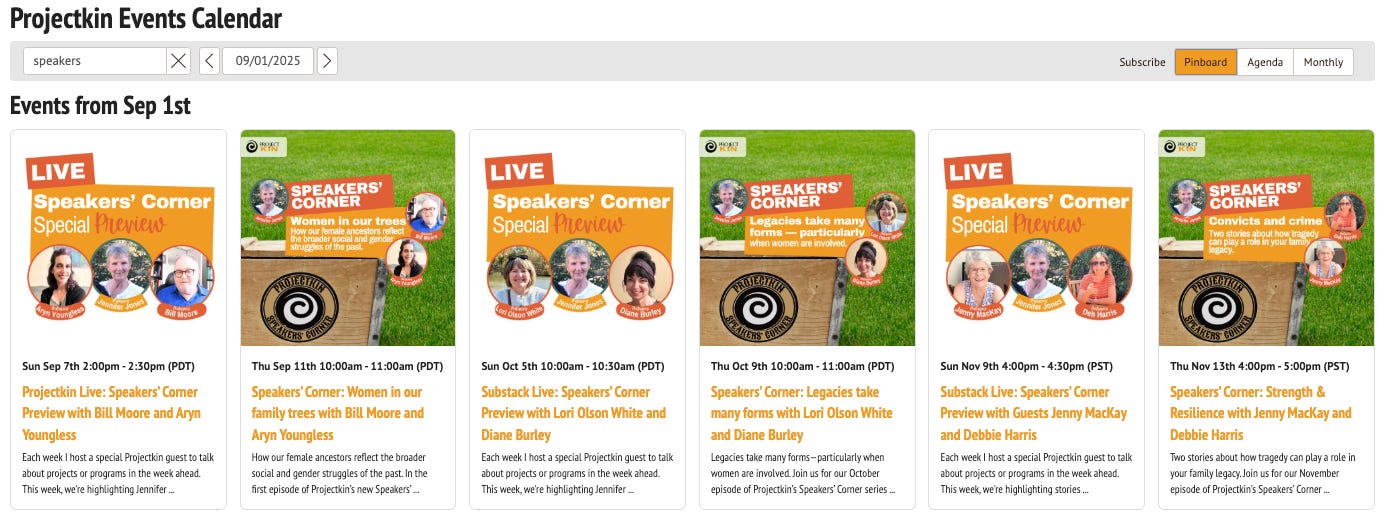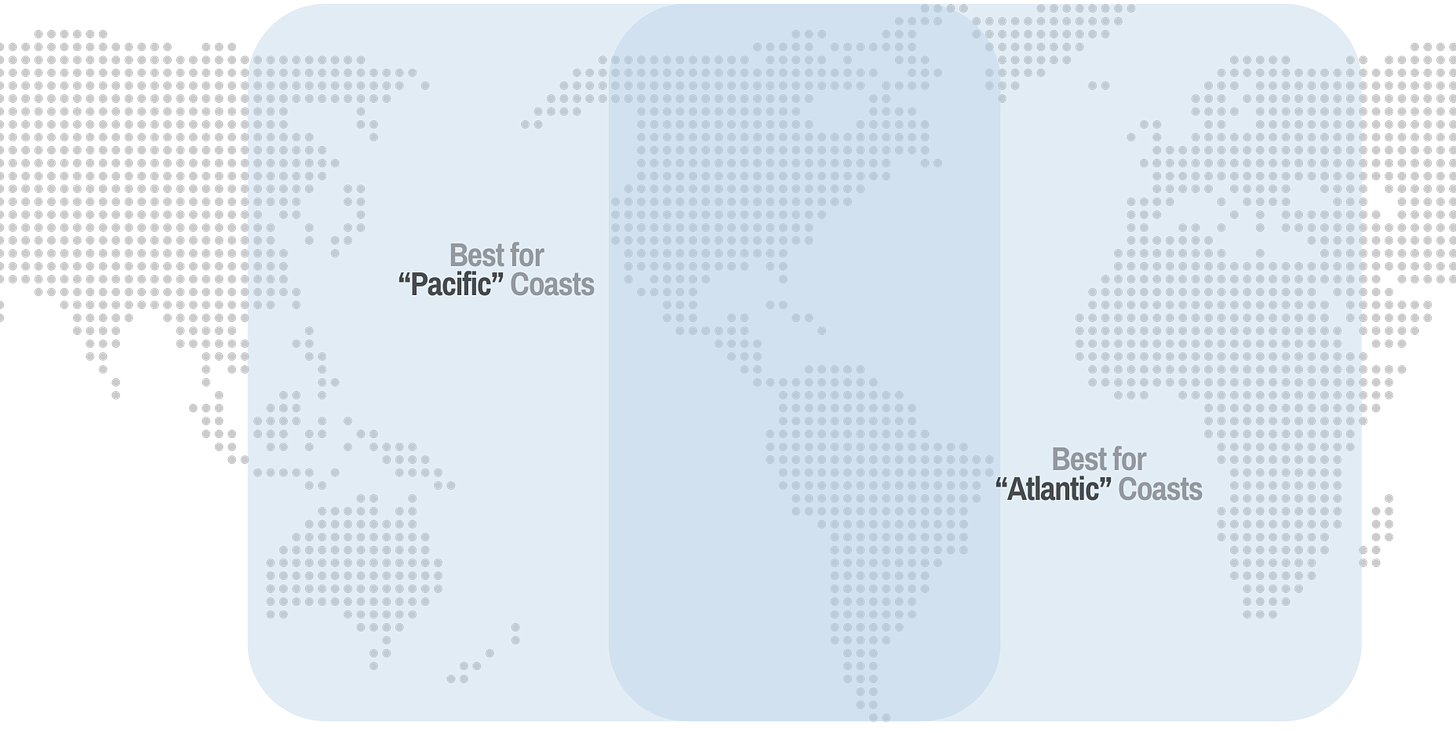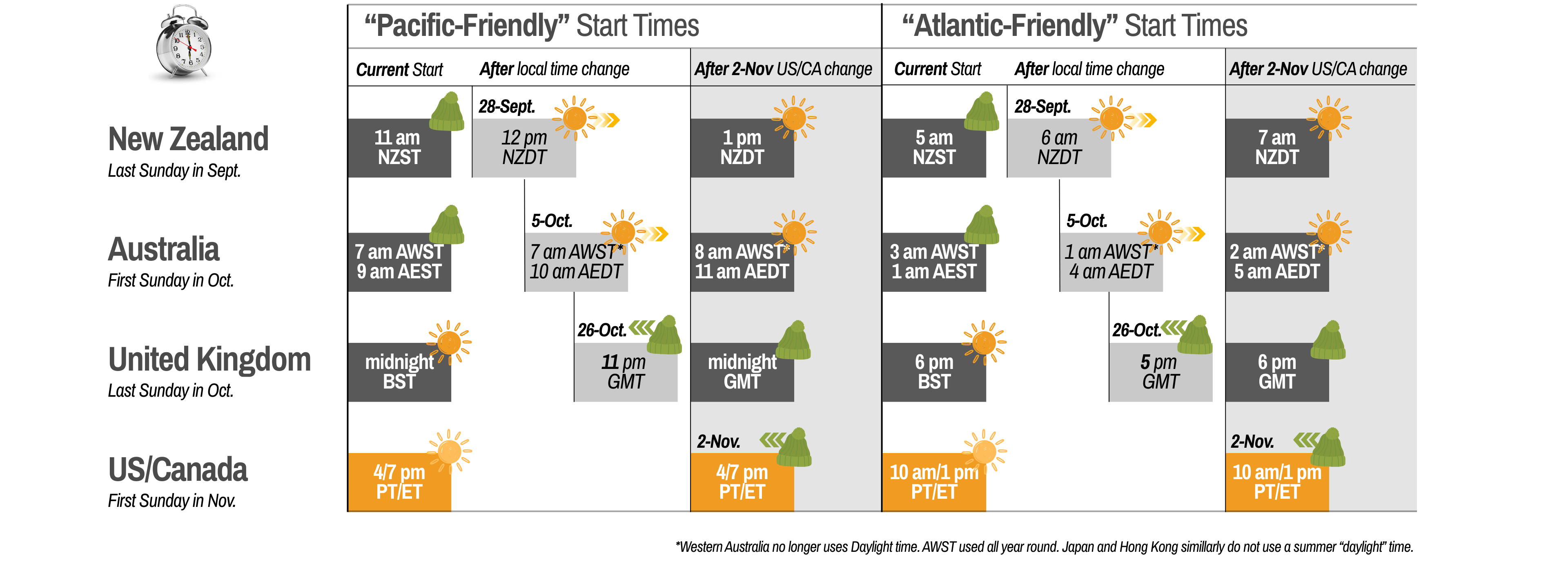Changing Seasons, Changing Times
Starting 28-Sept, our Northern Atlantic and Southern Pacific clocks start their Spring forward and Fall back. Let's get ahead of it by synchronizing on a few planned schedule changes.
If you’ve participated in any Projectkin events, you’ll probably know I have a peculiar penchant for scheduling programs for what I call Atlantic-friendly and Pacific-friendly start times.
There’s a method to the madness.
The globe spins around the sun every 24 hours. To synchronize modern clocks, we settled on a system of 24 time zones marked hourly relative to the local mean time at the Royal Observatory in Greenwich, London. Greenwich Mean Time (or GMT) is the basis for civil time in the UK.1 By a happy coincidence of geography, California lies on the Western edge of the Americas such that:
UK and Europe lie to our East, and are 8-9 hours ahead of us.
Australia, New Zealand, and Asia are roughly 15-19 hours ahead of us. (Using a quick mental model: 5-9 hours back and a day ahead.)
From California, this creates two natural time slots2:
🌞 A slot in the morning that’s preferable for the Atlantic coasts of Europe and convenient across the Americas:
🫖 A slot in the afternoon that’s preferable for the Asian/Pacific nations and convenient across the Americas.
Now Add Seasonal Changes
The trick, of course, is that in the Northern and Southern hemispheres we generally change our clocks to Spring forward and Fall back. If that’s not enough, our varying geography and politics won’t let us agree on a single global date for these changes. Instead, they take place regionally, leaving us scrambling to keep up.
This year, the changes occur in four stages over six weeks, starting on Sunday, September 28th. Each date affects relative time differences, so that scheduling can be very confusing. These are the key dates to keep in mind:
September
Last Sunday, 28 Sept: New Zealand jumps ahead to daylight time, NZDT
October
First Sunday, 5 Oct: Most states in Australia jump ahead to daylight time, AEDT, for example. Queensland, the Northern Territory, and Western Australia no longer do so.
Last Sunday, 26 Oct: UK falls back from BST to GMT.
November
First Sunday, 2-Nov: Most regions of the US and Canada will switch from Daylight Saving Time to Standard Time. Mexico no longer observes DST.
Projectkin Events
As the seasons change, the start times for Projectkin events change with North American clocks. To anticipate local start times in your region, you may need to review the Projectkin Events calendar (which uses your local clock to calculate start times on any given day in the future) or online tools like WorldTimeBuddy3.
Planning for Order
The chart below visualizes Projectkin event start times in our four major Anglophone regions. Note the peculiar start times this creates in New Zealand, Australia, and the UK weeks before the North American “fall back” on November 2nd.
New: All Events at either Pacific or Atlantic-friendly times
In trying to sort through the subtle mysteries of these biannual time changes, I realized I still had a few events outside the Atlantic/Pacific time windows. Why not fix that?
So, starting on September 28th, the following events will be scheduled at either Pacific or Atlantic times:
Kathy’s Corner: Historically, these events were a special case that started at 3/6 p.m. PT/ET (because my special host,
, is in Calgary, Alberta, Canada, where it was 4 p.m. MT).
From October forward, these programs will start at the Pacific-friendly hour of 4/7 p.m. PT/ET.
Substack Live Previews: Since January 2025, this weekly program has been held on Sundays at 2/5/10 pm PT/ET/BST or Monday at 6/8 a.m. AEDT/NZDT. Though these events have been a hit, they impose a late hour in Europe and an unreasonably early hour in Asia/Pacific.4
Starting on September 28, these programs float between Pacific and Atlantic-friendly times depending on our guests across the globe. See the calendar for specific events.
All of these changes have now been made to the Projectkin calendar, which you can always find at Projectkin.org/events.
Your Computer Calculates Start Times
Many don’t realize that their computer, phone, or tablet calculates program start times when viewing the Projectkin Events Calendar. This is done using a third-party service called Tockify.com, which hosts all event pages for Projectkin. From the Events page, you can expand the embedded calendar to fill your browser window by going to the Events Calendar and tapping on the Fullscreen button.
Expanded Calendar Views
With the calendar expanded to full screen, you can explore Tockify calendar view options:5
Move forward and backward on the calendar by changing the date.
Use Pinboard and Agenda views as an alternative to the Monthly view.6
Use the search window to filter events by title. In the example below, all Speakers’ Corner events and previews are shown by entering the word “Speakers”

Last thoughts
As I make these changes to our calendar, it seems appropriate to pause for a moment to thank my incredible partners over this last year:
, , and . We’ve also had the benefit of fantastic special guests, and of course, our member programs. Every one of our speakers contributes their time to these programs as a volunteer. Projectkin is platform independent, and we don’t accept sponsorships or affiliate funds. You can explore past programs at Projectkin.org/event-recordings. Your visits to their publications and discussion of their work are excellent ways to thank them.Projectkin programming is offered for free because of the generous support of our Patrons. If you'd like to join us in our mission to encourage families to share their stories, we’d love to have you as a patron too.
If time changes are mysterious to you, here’s a simple way to look at it: Our clocks in Berkeley, California, and everywhere on Pacific Standard Time strike 10:00 a.m. eight hours after Big Ben has done the same in London. (Thus, our clocks are set at GMT-8.) If you look at it the other way around, at 10 a.m. in California, it is 6 p.m. in London. British Summer Time and Daylight Saving Time in the US and Canada push that ahead an hour, but the time difference is the same.
To keep this simple, these GMT calculations are based on times on January 1, 2026.
Using WorldTimeBuddy, modify the calendar option when you project the start time for a future event.
For Substack Live, Emma Cox and I have experimented with a special Friday program at 8/11 a.m. PT/ET and 4 pm BST. We’ll continue this on Friday, September 12th, but after the 28th, we’ll switch to an “Atlantic-friendly” start, so the following episode will be on Friday, October 10th.
You may have noticed that when you tap on an event, the URL changes to reference the Tockify.com domain. I started using this tool at Tami Mize's recommendation at ConferenceKeeper.org. Though the interface can be counterintuitive, it’s inexpensive and incredibly reliable. (I get no affiliate fees, I’m simply a fan.)
I recommend you avoid the Subscribe button to the left of the option “Pinboard.” It's confusing and utterly unrelated to Substack. It’s a Tockify feature that integrates with Google, Outlook, Yahoo, and other calendars. It’s unnecessary for this basic function.









What I discovered was tricky… telling global citizens what time the event was in their part of the world. I get left and right mixed up too. I’m thinking there’s a connection 🤔
Thank you, Barbara. I read every word. You did a lot of work. I’m awarding you this 🏆 because you deserve it. 🥰